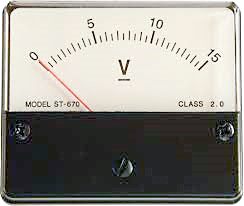property>voltage
What is Voltage?

Voltage is also known as electrical potential difference. It is denoted with symbol 'V' and the SI unit for voltage is the volt. Voltage difference is the force, known as electromotive force (or e.m.f.), which drives a conventional current from a point of high potential to lower potential. This concept of voltage difference is similar to the concept of a pressure difference that drives the flow of water (which would be analogous to the electric current). Usually, when we mention voltage we are referring to voltage difference; the voltage drop across some device. So voltage or voltage drop across the device means the same and is taken as difference between two potentials. Voltage can be calculated with the formulae:-
V = I.R
P = I.V
Where V = voltage difference (volts), I= electric current (amperes), R= Resistance (ohms), P= Power (watts)
The above formulae are for direct current (DC) circuits. For alternating currents (AC) the formulae are more complicated:
V = P/I.cos(x)
V = I.R/cos(x)
The voltage drop can be across a resistor, capacitor or inductor, so all three have a different formulae,
Resistor:-
Vr = IRr
Capacitor:-
Vc = IXc
Inductor:-
VL = IXL
Where V= Voltage Difference, I = Current, R= Resistance, X= Reactance, Xc indicates capacitor reactance and XL indicates inductor reactance.
How Voltage is Measured
A voltmeter is used to measure voltage difference and usually works by allowing a tiny current to flow through a moving coil meter (or digital equivalent) in series with a resistor. The voltmeter is actually measuring the current passing through this resistor, as current is directly proportional to the voltage difference across the resistor. The value of the resistor is chosen depending on the voltage range to be measured. The sensitivity of the meter must be sufficient to ensure that the current drawn by the meter is small enough that it does not affect the voltage being measured. Voltage can also be measured using a potentiometer or an oscilloscope. The cathode ray oscilloscope uses the voltage difference (usually after amplification) to deflect an electron beam which can be measured by means of a graticule on the oscilloscope display, and also be interpreted visually as a changing voltage waveform over time.
Voltage as low as 50V can lead to lethal shock under certain circumstances, although it is the magnitude of the resulting current passing through the body that presents the danger. Whenever there is high voltage, safety becomes a concern. In cathode ray tubes, generation of X-rays and particle beams, high power amplifier vacuum or any scientific or industrial applications, high voltages are used. Voltages that are greater then 50V if applied to human skin can produce heart fibrillation if sufficient current passes through body tissues, for example if the skin is wet or if there are any wounds on the body.